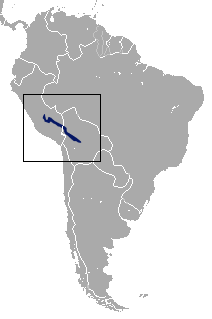
Opossums are members of the marsupial order Didelphimorphia endemic to the Americas. The largest order of marsupials in the Western Hemisphere, it comprises 126 species in 18 genera. Opossums originated in South America and entered North America in the Great American Interchange following the connection of North and South America.
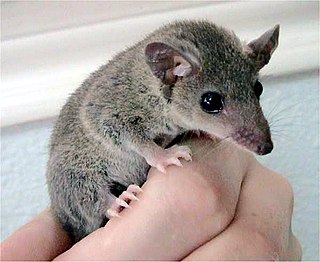
Monodelphis is a genus of marsupials in the family Didelphidae, commonly referred to as short-tailed opossums. They are found throughout South America. As of January 2019, the most recently described species is M. vossi.

Emilia's short-tailed opossum is an opossum species from South America. It is found south of the Amazon River from eastern Peru, through Bolivia, to central Brazil.
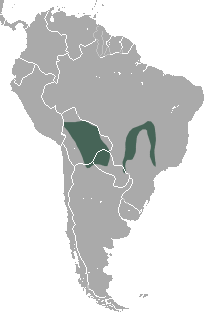
The pygmy short-tailed opossum, scientifically named Monodelphis kunsi, is an opossum species from South America. M. kunsi is a marsupial from the family Didelphidae of the order Didelphimorphia. Although it is a marsupial, it lacks the characteristic pouch that is often associated with this order. It is found in Argentina, Bolivia, Brazil and Paraguay. M. kunsi is considered a smaller species within the family Didelphidae, which is why it is named a pygmy opossum. The young are referred to as 'joeys'. The females are referred to as 'Jill,' and the males 'jack'. It was thought to have been endangered in 2001, but has since been moved to least concern by the International Union for Conservation of Nature.

The chestnut-striped opossum is an opossum species from South America. It is found in Brazil. More specifically, it is found in East and Central Brazil, including areas such as Goiás, Minas Gerais, and São Paulo. It is terrestrial and is active around twilight. There has been a population depletion of about 20% in the last 10 years due to deforestation and habitat loss. It is nearing Threatened, but the exact number of their species in unknown.

The southern red-sided opossum is an opossum species from South America. It is found in Argentina, Brazil and Paraguay.

The northern three-striped opossum is an opossum species from South America.
Osgood's Ethiopian toad is a possibly extinct species of toad in the family Bufonidae endemic to the mountains of south-central Ethiopia. It was named for the American biologist Wilfred Hudson Osgood who carried out fieldwork in Ethiopia for the Field Museum in 1926–27. He collected the original specimens of Osgood's Ethiopian toad and three other endemic species of anuran.

The southern martin is a species of bird in the family Hirundinidae.

The wood sprite gracile opossum is a mammal. It is a species of opossum in the family Didelphidae. It is found in Colombia and Venezuela. Its natural habitat is subtropical or tropical moist lowland forests. It is threatened by habitat loss.
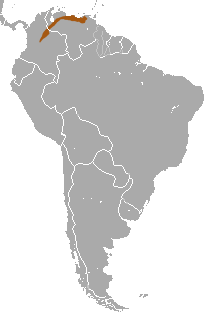
The northern gracile opossum is a species of opossum in the family Didelphidae. It is found in Colombia and Venezuela. G. marica naturally occurs in subtropical or tropical moist lowland forests.
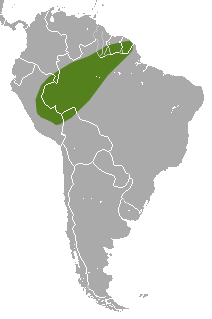
Kalinowski's mouse opossum or the Peru gracile mouse opossum is a species of opossum in the family Didelphidae. It is found in Brazil, French Guiana, Guyana, and Peru. Its natural habitat is subtropical or tropical moist lowland forests at elevations up to 1000 m.
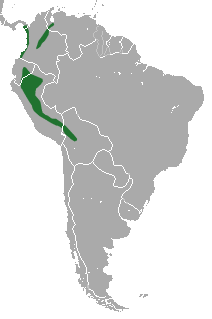
The sepia short-tailed opossum is a species of opossum in the family Didelphidae found in Colombia, Ecuador, Panama, Peru and Venezuela.

Brown's pademelon is a species of marsupial in the family Macropodidae. It is found in New Guinea. Its natural habitats are subtropical or tropical dry forests, dry savanna, subtropical or tropical dry shrubland, and subtropical or tropical dry lowland grassland. It is threatened by habitat loss.

The robust golden mole is a species of mammal in the golden mole family, Chrysochloridae. It is endemic to parts of Mpumalanga province in South Africa. Its natural habitats are temperate forests, subtropical or tropical moist lowland forest, temperate and subtropical or tropical dry shrubland, dry lowland grassland, arable land, pastureland, plantations, rural gardens, and urban areas.
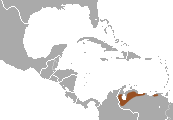
The hooded red-sided opossum is a South American opossum species of the family Didelphidae. Until recently, it was viewed as a subspecies of M. brevicaudata. It is found in Colombia and Venezuela at altitudes from sea level to 2250 m. It is a primarily nonarboreal resident of tropical rainforest, but has also been seen in areas under cultivation.
The Peruvian short-tailed opossum is a species of marsupial in the family Didelphidae.It is found in Bolivia and Peru.

Ronald's opossum is a South American opossum species of the family Didelphidae. It was discovered in 2004, and most closely resembles M. adusta. It is known only from Manú National Park, Peru, where it inhabits the Amazon rainforest. It is named after American zoologist Ronald H. Pine.
